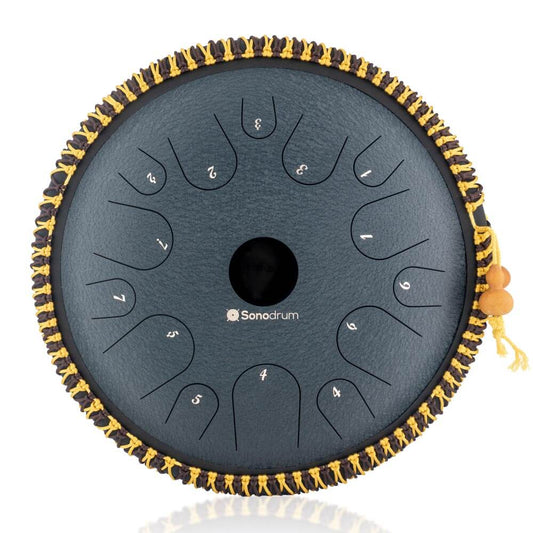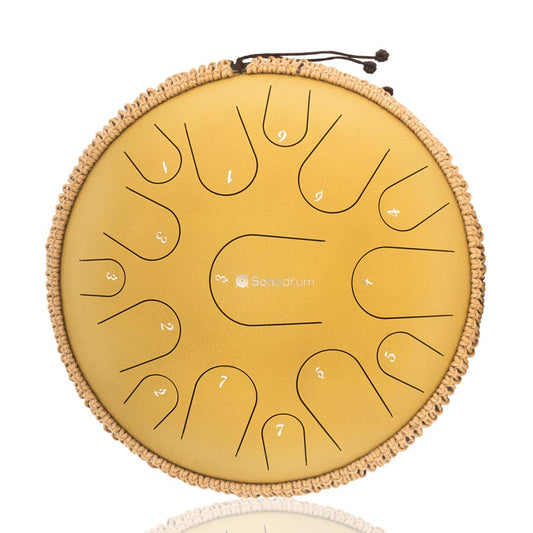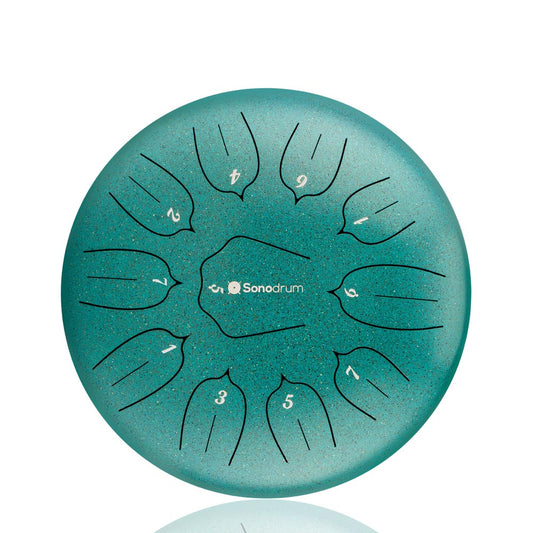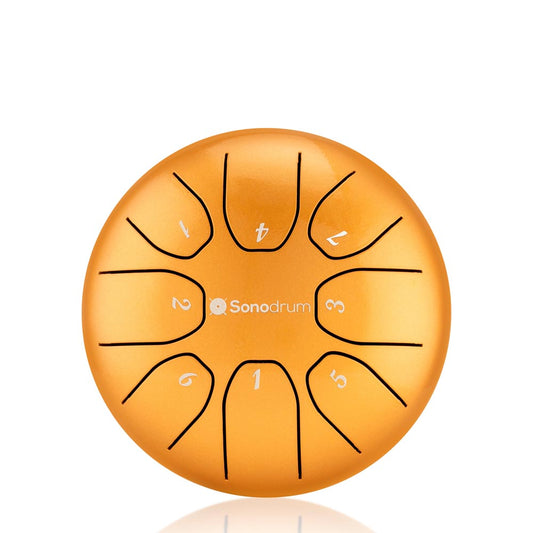In the fascinating landscape of percussion instruments, the Sonodrum and Handpan stand out, each offering their own unique sounds and musical possibilities. The Sonodrum is a contemporary twist on traditional drumming, designed to create rhythmic patterns that engage both musician and listener. In contrast, the Handpan is celebrated for its full-bodied, mesmerizing tones that have captivated audiences across various genres. This article aims to dive into a comprehensive musical instruments comparison, examining their distinct sonic identities while navigating the intricate world of unique percussion instruments.
Key Takeaways
- The Sonodrum blends traditional drumming with modern innovation.
- Handpans are known for their soothing, resonant sounds.
- Both instruments offer unique and engaging auditory experiences.
- The musical versatility of each instrument appeals to various genres.
- Understanding their characteristics helps musicians choose the right instrument.
Introduction to Unique Percussion Instruments
Percussion instruments play a vital role in music, bringing rhythm and texture to compositions. Understanding sound is fundamental for musicians and listeners alike. It involves a comprehension of frequency, resonance, and how these elements affect our emotions when we hear music. This connection between sound and feeling makes exploring the nuances of percussion particularly fascinating.
Understanding the Basics of Sound
To fully appreciate percussion instruments, one must first grasp the basic concepts of sound. Every note produced results from vibrations that create waves, which travel through different mediums. These waves vary in frequency, influencing pitch and volume. The resonance of a percussion instrument contributes significantly to its unique sound. Instruments like the Sonodrum and Handpan demonstrate how different materials and shapes impact auditory experiences, making sound exploration an essential part of musical education.
The Rise of Alternative Percussion
In recent years, there has been a remarkable surge in interest in alternative percussion instruments. These unique instruments, such as the Sonodrum and Handpan, are captivating musicians with their distinctive auditory qualities. This trend reflects a wider appreciation for world music and a desire for creative expression beyond traditional norms. As musicians seek new avenues to explore sound, alternative percussion instruments provide fresh, innovative ways to engage with music, captivating audiences and encouraging widespread exploration.
Sonodrum: A Deeper Dive
The Sonodrum is a fascinating instrument that blends traditional and contemporary elements, making it a favorite among musicians exploring unique percussion styles. Understanding its design and functionality reveals much about its appeal and versatility in various musical settings.
What is a Sonodrum?
The Sonodrum is an innovative percussion instrument crafted from high-quality materials such as metal and wood. Its design allows for a rich and resonant sound that captivates both players and audiences alike. This instrument breaks away from conventional drum sounds, presenting a fresh auditory experience that stands out in the world of percussion.
Characteristics and Sound Profile
One of the most compelling Sonodrum features is its ability to produce a wide tonal range. Musicians often describe the Sonodrum sound profile as warm and inviting, with exceptional clarity. This instrument can produce both soft, ambient tones and dynamic rhythms, making it suitable for a variety of music genres. Its unique sonic quality engages listeners, drawing them into an immersive auditory experience.
Playing Techniques and Styles
Exploring Sonodrum playing techniques reveals a multitude of possibilities for expression. Musicians can utilize a variety of strikes and mallets to create different sound textures. Techniques such as rolling, tapping, and dragging produce intricate patterns, allowing for both rhythmic and melodic compositions. As a versatile instrument, the Sonodrum encourages players to explore and experiment with unique percussion styles.
Handpan: The Enigmatic Alternative
The handpan stands out within the realm of alternative percussion instruments due to its unique construction and ethereal sound. This instrument typically features a hollow, convex shape made from metal, which is meticulously tuned to create a variety of rich, resonant tones. Understanding the defining characteristics of the handpan reveals its place in contemporary music.
What Defines a Handpan?
Handpan characteristics include its distinctive note layout and the method of creating sound. Tuned to specific scales, each handpan can produce a series of musical notes that blend seamlessly together. This tuning allows musicians to explore a range of expressions, making the handpan not just an instrument but an emotional outlet. Various artists have adopted the handpan to convey feelings and tell stories through sound.
Sound Quality and Musical Versatility
Renowned for its exceptional handpan sound quality, this instrument offers a calming audio experience. The soothing tones resonate beautifully, captivating audiences in a wide array of settings—from intimate gatherings to large performances. The musical versatility of the handpan allows for exploration across genres, including classical, electronic, and even world music. Renowned artists such as Hang Massive and Amani Ameer demonstrate the instrument's adaptability through innovative compositions that showcase its diverse capabilities.
| Aspect | Handpan | Traditional Percussion |
|---|---|---|
| Construction | Metal, convex shape | Varies (wood, metal, etc.) |
| Tuning Method | Specific scales | Standard tuning methods |
| Sound Quality | Calming, resonant | Varies widely |
| Musical Versatility | Cross-genre adaptability | Often genre-specific |
| Emotional Impact | Deeply resonant | Varies by style |
The handpan's ability to merge sound quality and musical versatility makes it a cherished choice among musicians and enthusiasts alike, redefining the landscape of alternative percussion instruments.
Sonodrum vs. Handpan: Comparing Their Sounds
The sonic landscapes of Sonodrum vs. Handpan sounds offer unique auditory experiences that resonate deeply with listeners. By examining these instruments side by side, one can appreciate the distinct timbres and resonances they produce. This auditory comparison reveals not just technical qualities, but also how each sound elicits a strong emotional response and engages the audience in different ways.
Auditory Experience: A Side-by-Side Comparison
The Sonodrum features a vibrant, crisp tone characterized by its synthetic material, which gives it a clear and penetrating sound. In contrast, the Handpan, crafted from metal, produces warmer and more mellow tones that blend seamlessly in a variety of musical styles. This difference creates a stark auditory comparison that provides musicians and listeners with ample choices based on the mood or atmosphere desired.
| Instrument | Sound Quality | Resonance | Use Cases |
|---|---|---|---|
| Sonodrum | Crisp, clear tone | Bright resonance | Electronic music, performance art |
| Handpan | Warm, mellow tone | Soft resonance | Meditation, acoustic performances |
Impact on Listener Emotion and Engagement
The emotional impact of sound plays a critical role in how individuals connect with music. The Sonodrum, with its high-energy sound, often stimulates excitement and can energize a crowd quickly. Alternatively, the Handpan’s soothing melodies create an inviting atmosphere, ideal for introspection and relaxation. Understanding these nuances is essential for musicians aiming to enhance listener engagement through their craft.
Practical Considerations for Musicians
Musicians exploring the Sonodrum and Handpan face important practical considerations. Affordability and accessibility play crucial roles in decision-making, especially for those on a budget. The learning curve and opportunities for musical skill development are additional factors to consider.
Affordability and Accessibility of Each Instrument
When evaluating Sonodrum affordability against Handpan accessibility, musicians will find varying price ranges and features. The Sonodrum typically comes at a lower price point, appealing to those seeking an entry-level instrument. In contrast, Handpans may demand a higher investment, although they offer unique tonal qualities and a captivating aesthetic.
| Instrument | Average Price Range | Accessibility Level |
|---|---|---|
| Sonodrum | $200 - $600 | High |
| Handpan | $1,200 - $3,000 | Moderate |
Learning Curve and Skill Development
The learning curve associated with each instrument offers varying challenges and rewards. The Sonodrum allows for rapid engagement, with a more intuitive design that fosters early musical achievements. In contrast, the Handpan introduces a complex approach, requiring dedicated practice and patience for effective mastery.
- Sonodrum: Ideal for beginners, the instrument supports quick learning and early success.
- Handpan: Provides deeper musical opportunities that demand a commitment to skill development.
Resources such as tutorials, online courses, and lessons from seasoned musicians can significantly aid in this learning journey. An investment in practice time will enhance proficiency for both the Sonodrum and Handpan, showcasing the beauty of rhythmic expression.
Conclusion
In the vibrant world of percussion, the Sonodrum and Handpan stand out as two unique percussion instruments that offer distinct auditory experiences. Through our Sonodrum and Handpan comparison, we have explored their sound characteristics, playing techniques, and the emotional resonance they evoke. Each instrument has its own unique qualities, from the rich tonal layers of the Sonodrum to the ethereal melodies produced by the Handpan.
As musicians delve into their craft, understanding how these instruments fit into contemporary music settings becomes increasingly important. The Sonodrum delivers a rhythmic foundation that enhances ensemble performances, while the Handpan resonates with a tranquil and introspective quality, ideal for solo explorations. This diversity encourages musical exploration, allowing artists to express themselves in various ways.
Ultimately, the choice between the Sonodrum and Handpan hinges on personal preference and the desired emotional connection they bring. Both instruments invite players and listeners alike to embark on a journey of sound, creating enriching experiences that transcend traditional boundaries. Engaging with these unique percussion instruments not only broadens one’s musical palette but also deepens the connection to the art of sound itself.
FAQ
What is the main difference between a Sonodrum and a Handpan?
The Sonodrum is a contemporary percussion instrument that focuses on dynamic sound and versatility, often incorporating materials like metal and wood. In contrast, the Handpan produces more ethereal tones and is specifically tuned to create resonant melodies. Both offer unique sonic experiences, but their sound profiles cater to different musical styles.
How do I choose between a Sonodrum and a Handpan?
Choosing between the Sonodrum and Handpan largely depends on your musical goals. If you’re interested in creating rhythmic patterns and diverse soundscapes, the Sonodrum may be the ideal choice. If you prefer soothing melodies and ambient music, the Handpan would fit your needs better. Consider trying both to see which one resonates with you.
Are Sonodrums and Handpans affordable for beginners?
The prices can vary widely. Generally, Handpans tend to be on the higher end of the spectrum due to their intricate crafting and tuning processes. Sonodrums, on the other hand, may be found in a broader price range, making them more accessible for beginners. It's essential to compare prices and quality to find an instrument that fits your budget.
Is there a steep learning curve for playing these instruments?
The learning curve for both the Sonodrum and the Handpan can vary based on your musical background. While both instruments are approachable, mastering them takes time and practice. The Sonodrum may require various playing techniques, while the Handpan often focuses on melodic patterns. Utilizing online tutorials and seeking guidance from experienced players can accelerate your learning.
What genres of music are best suited for the Sonodrum and Handpan?
Both instruments are versatile and can fit into various musical genres. The Sonodrum is popular in ambient, world, and contemporary percussion music, while the Handpan excels in genres like world music, meditative, and electronic. Artists often blend different styles, so don’t hesitate to experiment!
Can I perform with a Sonodrum or Handpan in a group setting?
Absolutely! Both the Sonodrum and Handpan work well in group performances. Their unique sound profiles can complement other instruments, creating rich, layered music. Whether in a band, ensemble, or solo setting, you’ll find opportunities to incorporate these instruments into various musical contexts.
Are there notable musicians known for playing the Sonodrum and Handpan?
Yes! Many musicians have gained recognition for their innovative use of these instruments. Check out performers like Daniel Waples and Hang Massive for the Handpan, and look for contemporary percussion composers who showcase the Sonodrum in their works. Their styles can inspire your own journey with these fascinating instruments.




